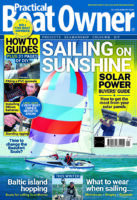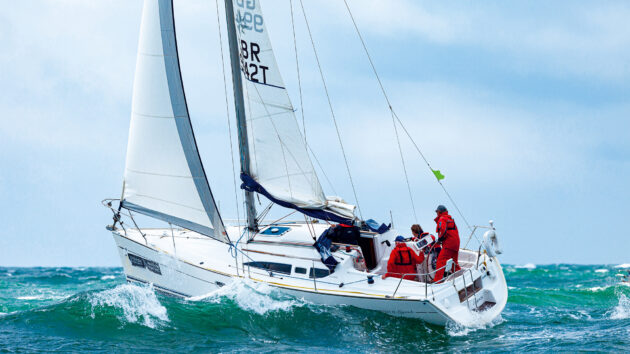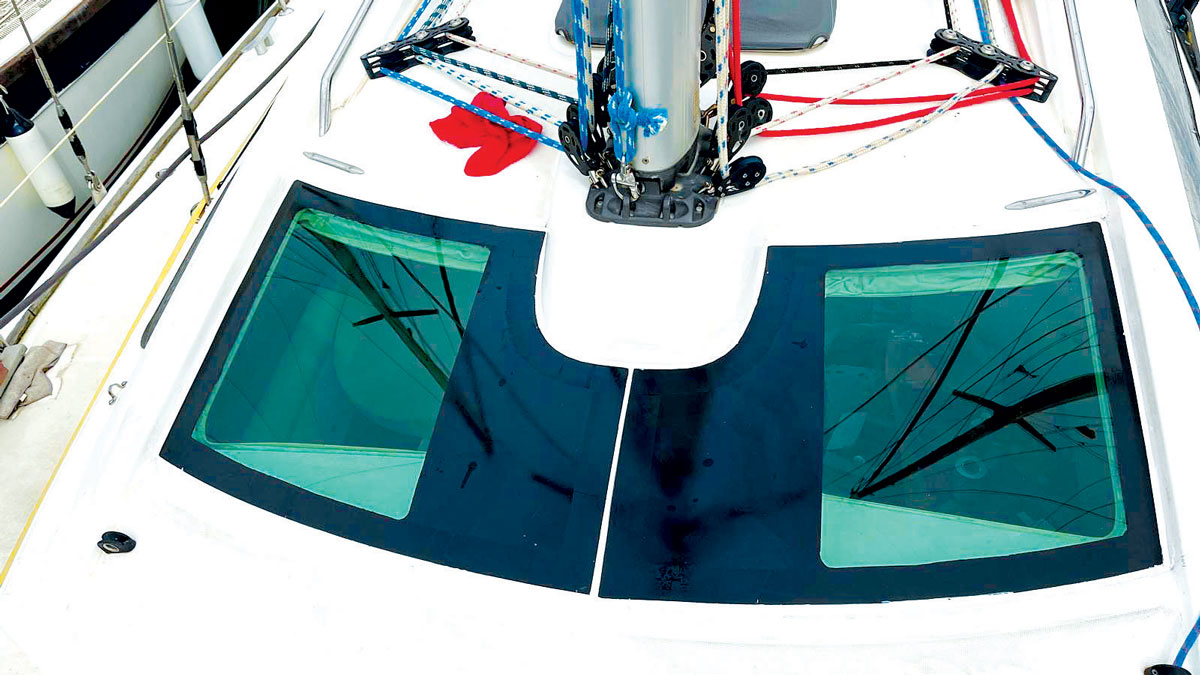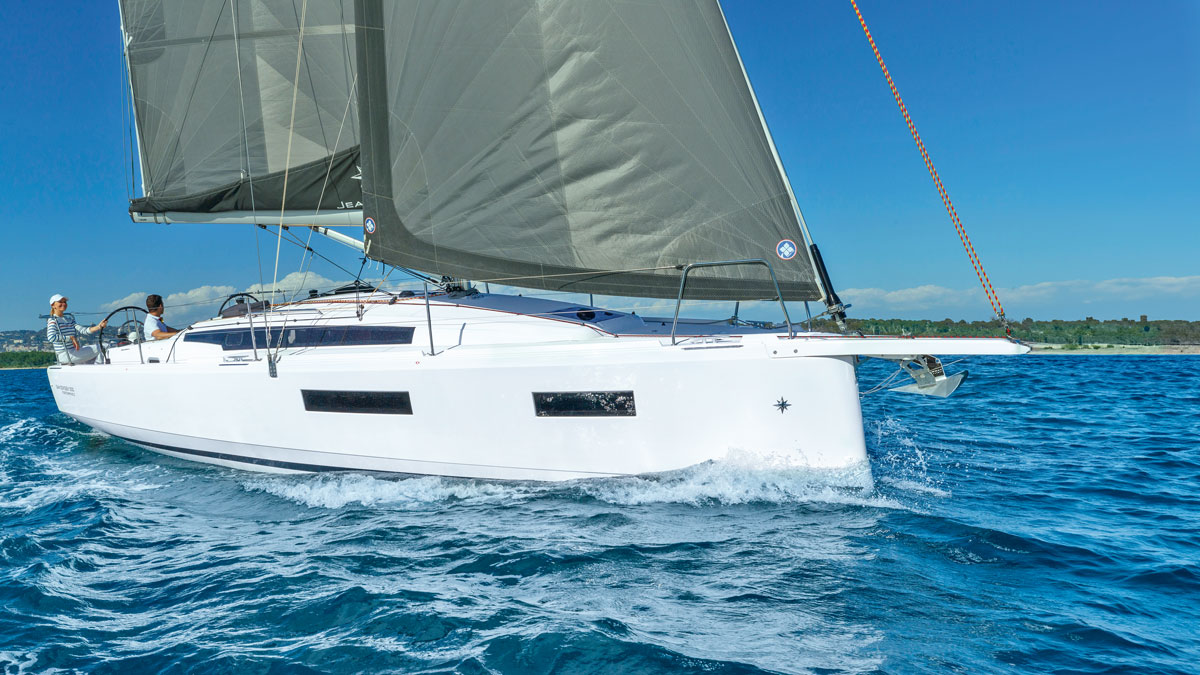Rupert Holmes compares the Jeanneau Sun Odyssey 32 with 8 other 31ft and 32ft used boat designs from the late 1990s and early 2000s
The Jeanneau Sun Odyssey 32 is the queen of small family cruisers, but how does it stack up against comparable models?
By the early 2000s, cruising yacht design had moved on enormously compared to 15 years earlier. Low centre of gravity keels that offered both useful weight reduction along with improved stability were now the norm.
Equally, designers had figured out how to make a fast hull shape with high internal volume without sacrificing sailing characteristics. As a result, many of the 31ft and 32ft cruisers of this era offer as much comfort and space as many 36-footers did in the 1980s.

The Jeanneau Sun Fast 32 was built from 1993-2001, with around 100 boats built. Photo: David Harding
At this time, Jeanneau tended to offer slightly more performance-oriented cruising designs than sister brand Beneteau’s Oceanis range, but without as much compromise on interior space as the latter’s First series of performance cruiser racers (check our buying guide for used a Beneteau Oceanis).
These vintage 31/32ft family cruisers are a popular category, with many great options to choose from. We’ve taken an in-depth look at more second-hand classic boats of this size before.
Jeanneau Sun Odyssey and Sun Fast 32 below deck
The Philippe Briand-designed Jeanneau Sun Odyssey 32 was effectively available in two versions, the second dubbed the Sun Fast 32, which benefitted from a deeper keel with 1.95m draught, plus a taller rig, giving almost 20% more sail area, as well as uprated deck gear.
In many ways, this was the more desirable version for owners for whom the deeper draught is not a restriction. However, the market for new boats has always been very price sensitive, and the Jeanneau Sun Odyssey version has sold in much greater numbers.
An increased beam relative to earlier designs is carried well aft, which promotes speed, thanks in part to greater form stability, while increasing interior space. But these benefits come at the expense of a slightly more lively motion at sea.

The spade rudder on both versions allows for reliable control and manoeuvrability. Credit: David Harding
Both the Sun Fast and Jeanneau Sun Odyssey models offer the same spacious interior, including an unusually large U-shaped galley and an aft heads located near the companionway, where the motion of the boat is least. Forward of this is a conventional saloon with settees on each side of a folding central table. At the end of the starboard settee is a small aft-facing chart table.
Overall, it’s a fairly bright space, even if some boats have darker joinery than would be fashionable today. It’s also well laid out, though stowage is limited for extended periods on board.
The forecabin is not as spacious as those on larger boats, but it offers some standing space in which to get changed and a hanging locker in addition to the double vee-berth.
The aft cabin has a particularly large double berth arranged transversely, together with a large standing/changing area and useful stowage.
Sailing the Jeanneau Sun Odyssey and Sun Fast 32
Another important change around this time was a move away from cumbersome overlapping genoas to smaller jibs and more of an emphasis on power from the mainsail. Today’s efficient slab reefing systems, including arrangements that can be handled entirely from the cockpit, make these larger mainsails easy to tame. The jib is also far easier to sheet in after each tack than a genoa and set with a more efficient shape when part furled in stronger winds.
While some single-rudder yachts with a broad transom have a reputation for being difficult to control and a tendency to broach easily, this doesn’t appear to be the case with this design. I’ve raced a Sun Fast 32, for instance, running under spinnaker in gusty conditions, with the true wind speed reaching 22-24 knots, without issue.
The tiller steering of the Sun Fast model suits a yacht of this size perfectly – it’s direct, with a lot of feel, and you can easily see the luff of the headsail. It’s also easier for manoeuvring short-handed, simply because no wheel gets in the way of the driver moving around the boat.
The Jenneau Sun Odyssey version typically has a coachroof-mounted mainsheet traveller, so it may not be as easy to achieve accurate sail trim, while boats with wheel steering may not have such a direct feel to the helm.
Various sources appear to give different overall length for the two models (9.6m for the Jeanneau Sun Odyssey and 9.5m for the Sun Fast), but this is simply a factor of different pulpit overhangs, and in both cases, the hull length is 9.35m (30ft 8in). Waterline length is also prone to variation due to differences in trim and loaded displacement. The figure quoted above represents a Sun Fast in light displacement mode, but a well-loaded Sun Odyssey may measure up to 18in longer on the waterline. Equally, a number of different keels were offered, so ballast figures may vary.
Jeanneau Sun Fast 32 Specifications
LOA: 9.50m/31ft 2in
Hull length: 9.35m/30ft 8in
LWL: 8.05m/26ft 5in
Beam: 3.30m/10ft 10in
Draught: 1.45m/4ft 9in or 1.95m/6ft 5in
Displacement: Jeanneau Sun Odyssey: 4,300kg/ 9,480lb)
Displacement: Sun Fast: 3,600-3,850kg/ 7,950-8,490lb
Ballast: approx 1,080-1,310kg/
2,380=2,890lb
Sail area: Jeanneau Sun Odyssey: 44.96m2/484ft2
Sail area: Sun Fast: 53.4m2/575ft2
Alternatives to the Jeanneau Sun Odyssey 32 & Sun Fast 32
Hunter Channel 31
This British-built David Thomas design from 2000 is one of my stand-out favourite boats from this period. It combines impeccable handling with good performance and proved a really lovely boat to sail when I tested the first fin keel example to leave the factory.

The Hunter Channel 31 combines excellent handling with a sophisticated and surprisingly spacious accommodation. Photo: David Harding.
It’s a boat that, should you wish, is possible to sail in close quarters under complete control. The optional self-tacking jib was a popular choice and makes handling super easy, especially if the boat is set up to reef the mainsail from the cockpit. Yet it is also a vessel that will take care of her crew at sea, even in challenging conditions.
Overall, it’s a slightly smaller craft than the Jeanneau, with a 39cm (1ft 3in) shorter waterline length and 15cm (6in) narrower beam. However, Hunter engaged the services of legendary interior designer and sailor Ken Freivokh to create a practical, ergonomic and stylish internal layout that has stood the test of time well.
There’s ample standing space in both the forward and aft cabins, as well as a comfortable saloon and a reasonable galley. The big outboard-facing chart table rivals that of many larger yachts, yet also makes the best use of the restricted beam and has a neat sprung stool that automatically stows out of the way against the chart table when not in use.
In addition to the fin keel model (with 5ft 11in/1.8m draught), the Channel 31 was also offered with deep, low centre of gravity twin keels and a 1.25m (4ft 1in) draught.
This proved a popular format, allowing access into many smaller harbours, as well as conferring a steadier motion at sea, yet without a major impact on performance.
Hunter Channel 31 Specifications
LOA: 9.37m/30ft 9in
LWL: 8.13m/26ft 8in
Beam: 3.15m/10ft 4in
Draught: 1.80m/5ft 11in or 1.24m/4ft 1in
Displacement: 4,300kg/9,480lb
Ballast: 1,609kg/3,550lb
Sail area: 42m2/450ft2
Beneteau First 31.7

The First 31.7 came with a standard deep fin keel, with a shoal draught fin keel on the options list. Photo: Mike Jones.
Most would likely see this performance cruiser as an alternative to the Sun Fast 32, rather than the Sun Odyssey model. Yet it also offers comfortable two-cabin accommodation, even if the forecabin is smaller than some.
The 31.7 was the second smallest vessel in the fourth generation of Beneteau’s First range and an enormously successful development of the Groupe Finot-designed Figaro 1 that was used for many years for the Solitaire du Figaro – the largest annual solo offshore event in the French calendar, with four legs typically totalling around 1,500 miles.
The base design’s intrinsic offshore capabilities are therefore well proven.
The 31.7 was launched in 1998 and set new expectations of what a yacht of this size could offer. It quickly proved popular among both cruising owners and race teams thanks to excellent handling, a greater level of stability than earlier designs, a powerful yet easily tamed rig and surprisingly spacious and civilised accommodation.
Waterline length is marginally longer than that of the Jeanneau, while the beam is slightly narrower. Displacement is also significantly lighter, helped by a lower figure for ballast, but the 1.9m (6ft 3in) draught – a much deeper figure than would previously have been acceptable for a boat of this size – means the bulb is low down, and stability doesn’t suffer.
A shoal draught version with a 1.45m (4ft 7in) keel was also offered.
Tiller steering, with mainsail controls easily to hand, including a cockpit-mounted mainsheet traveller, heightens the enjoyment of helming this boat while also making it easy to achieve accurate sail trim. As well as improving speed, this also makes a boat easier to steer and gives a more comfortable motion in awkward conditions.
Beneteau’s older Spirit 300 is also worth considering if your budget won’t stretch to a 31.7.
It’s a slightly smaller design, but still with a similar two-cabin layout and enviable sailing qualities. Unfortunately, few boats were sold in the UK, so they tend to be harder to find.
Beneteau First 31.7 Specifications
LOA: 9.61m/31ft 6in
LWL: 8.80m/28ft 10in
Beam: 3.23m/ 10ft 7in
Draught: 1.45 or 1.90m/4ft 9in
or 6ft 3in
Displacement: 3,750kg/8,270lb
Ballast: 1,025kg/2,260lb
Mainsail: 23.60m2/254ft2
Genoa: 28.90m2/320ft2
Legend 326

The Legend 326 has a high freeboard and plenty of interior space, as well as an efficient deck layout. Photo: David Harding.
Although an American design, this model from the early 2000s was built by Luhrs Marine at its UK factory in Portland, along with the Legend 306 and 356 models.
All were designed with a focus on comfort and ease of handling, with a spacious cockpit and wheel steering, plus a distinctive stainless steel arch that keeps the mainsheet and traveller clear of the crew, while still allowing for easy sail trim.
The backstayless B&R rig that allows for a powerful mainsail with a large roach was unusual at the time but has since been much copied, including by brands as varied as Pogo and Beneteau. While the 326s were aimed firmly at the cruising market, they surprised many with their sailing performance, which is better than the high freeboard and rather boxy coachroof suggests. This is especially true of deep keel models that are equipped with quality sails.
There was also a bilge keel version which proved popular and offered good performance. It’s a particularly appealing option for owners who sail in waters where the shallow draught and ability to dry out at low water are an advantage, but who want a larger and more modern craft than most twin keel designs.
In common with many American designs, the two-cabin layout includes a big U-shape galley that wouldn’t look out of place on many 40-footers. On the downside, the forecabin doesn’t offer any standing space and the berth in the aft cabin is arranged athwartships, so it doesn’t make a good sea berth.
Legend 326 Specifications
LOA: 9.73m/31ft 11in
LWL: 8.63m/28ft 4in
Beam: 3.30m/10ft 10in
Draught: 1.32m or 1.78m/5ft 10in or 4ft 4in
Displacement: 3,765kg/8,300lb
Ballast: 1,451kg/3,200lb
Sail area: 50.17m2/540ft2
Ballast: 2,556kg/5,623lb
Beneteau Oceanis 323

The spade rudder on both versions allows for reliable control and manoeuvrability. Photo: David Harding.
This is a slightly larger model, also designed by Groupe Finot, aimed firmly at the cruising market and is part of the fourth Oceanis generation.
Accommodation is particularly spacious, with excellent natural light and ventilation, as well as hull windows in the saloon. The raised coachroof gives excellent headroom aft of the mast, and there is standing space in both fore and aft double cabins, though stowage is not particularly generous, especially in the forecabin.
The L-shape galley is a decent size, though the aft-facing navigation table is on the small side for traditional chart work, but is fine when using a laptop or tablet. The heads compartment is also particularly large, though it stops short of having a separate shower stall.
Sail controls, aside from sheets for the non-overlapping jib, are led to the companionway, where they can be handled under the shelter of the sprayhood.
A downside to this is that the mainsheet cannot be reached from the wheel, and there’s no traveller so the sail shape is compromised when close-hauled.
A choice of three keels was offered, with most having the 1.45m (4ft 9in) draught shallow fin, though a deep 1.8m (5ft 11in) option was available.
The Oceanis 323 was also available with a lifting keel with a draught of only 0.8m (2ft 7in) with the keel raised and 2.0m (6ft 7in) with it lowered.
The cockpit is both spacious and comfortable, while a walk-through transom gives easy access to the bathing platform. This arrangement also facilitates easy and safe transfers to and from a dinghy.
Beneteau Oceanis 323 Specifications
LOA: 10.00m/32ft 10in
Hull length: 9.75m/32ft 0in
Beam: 3.26m/10ft 8in
Displacement: 4,230kg/9,330lb
Ballast: 1,095kg/2,410lb
Draught (fin keels): 1.45m or 1.80m/4ft 9in or 5ft 11in
Draught (lifting keel): 0.80/2.00m/2ft 7in/6ft 7in
Mainsail: 27.30m2/294ft2
Headsail: 22.90m2/246ft2
Hanse 320

The Hanse 320 came with a fractional sloop rig, with 106% self-tacking jib. Photo: Hanse.
This is a slightly later model by Judel/Vrolijk with clean lines, almost plumb bow and longer waterline length, built from 2007 over a four to five-year period.
Accommodation is refreshingly different, with good-sized fore and aft cabins that benefit from better than average stowage, plus a large saloon.
This has a larger U-shape settee to port around an offset table, with the inboard section of the aft end used as a seat for the aft-facing navigation table. On the downside, the starboard settee is a little short and, therefore, doesn’t make a viable sea berth other than for children or young teenagers. There’s also a well-appointed galley and good heads compartment conveniently next to the companionway.
Almost all Hanse 320s were sold with a self-tacking jib, plus single-line reefing for the mainsail’s first and second reefs, while the mainsheet is taken to a point on the cockpit sole just forward of the wheel pedestal. Some boats were also fitted with a mainsheet traveller in the cockpit, while others have a Lewmar folding wheel that opens up the cockpit space in port and facilitates access to the transom, which has a small fold-down boarding step.
Hanse 320 Specifications
LOA: 9.63m/31ft 6in
Hull length: 9.55m/31ft 3in
LWL: 8.72m/28ft 6in
Beam: 3.30m/10ft 10in
Draught: 1.53m or 1.84m/5ft 0in or 6ft 0in
Displacement: 5,200kg/11,464lb
Ballast: 1,480kg/3,260lb
Mainsail: 28.5m2/307ft2
Self-tacking jib: 22.87m2/246ft2
Elan 333

The Elan 333 is a slightly older but sportier model that still offers good accommodation and handling under sail. Photo: David Harding.
This is a larger and more performance-oriented option, yet older examples can change hands for similar prices to the Sun Fast and Sun Odyssey. Buyers will benefit from faster passage times and the boat’s excellent handling characteristics, yet interior volume is similar to that of the slightly smaller mainstream cruising designs in this selection.
This is a Rob Humphreys design from 1999 that was built in Slovenia until 2006. It is one of the yard’s most popular models, and even the designer chose one as his own boat for many years. It is quicker in light airs than many boats of a similar size, yet the combination of an easily tamed fractional sloop rig, deep low centre of gravity fin keel, plus a powerful spade rudder inspires confidence in testing weather.
While some boats, notably in the UK and elsewhere in northern European waters, were initially used for racing, this also proved a popular choice for cruising, especially in Croatia where a good number of boats started their lives in charter fleets. Deck gear is generally a notch above that of mainstream cruising designs of the same era.
Below decks, a generous beam helps create plenty of volume, although the forecabin is on the small side, and the use of darker woodwork can date the appearance.
Elan 333 Specifications
LOA: 9.99m/32ft 9in
LWL: 8.75m/28ft 8in
Beam: 3.46m/11ft 4in
Draught: 1.90m/6ft 4in
Displacement: 4,000kg/8,818lb
Ballast: 1,520kg/3,350lb
Sail area: 51m2/550ft2
X-332

The X-332 lay-up was hand-laid E-Glass glassfibre in isopthalic resin, which meant the hull came with a five-year warranty. Photo: Graham Snook / Future.
Arguably, this design from 1994 was well ahead of its time. More than 400 boats were built over an 11-year period, making it one of the most popular models ever from this prolific Danish yard. Like the Elan, it’s a larger and faster boat than the models from Jeanneau, yet it offers comparable accommodation.
A composite cast iron/lead bulb keel and fractional rig with discontinuous rod rigging were standard, while a Sport version with a deeper but lighter keel appeared in 2002. In the mid-1990s, big overlapping genoas were still popular, but an easy way to slightly depower this design for easier cruising is to change to a marginally overlapping jib of around 106-108%.
The tiller steering suits this design well, even when used solely for cruising, and the builder went to a lot of effort to engineer the bearings and geometry to minimise loads in the helm. It’s also possible to connect a below-deck autopilot that will hold a much better course than old-school tiller pilots, even in heavy weather.
PBO’s sister title Yachting World tested the boat when it was new, with Matt Sheahan finding it was a boat that, “…may err on the side of performance, but resists extremes.” He also reported that, “there are some yachts which just feel right from the very first moment you take the helm. The X332 is one such boat.”
Build quality was top-notch and includes X-Yacht’s trademark galvanised frame that spreads keel and rig loads, which has proved reliable over the years.
Suffice to say, the X-332 remains a very desirable model, even by today’s standards. Prices, even for older examples, therefore tend to be a notch above those of the other boats in this selection, though this, in part, also reflects that most are very well-equipped and well looked after.
X-332 Specifications
LOA: 10.31m/33ft 9in
Hull length: 10.06m/33ft 0in
LWL: 8.80m/28ft 11in
Beam: 3.30m/10ft 10in
Draught: (std keel) 1.80m/5ft 11in
Displacement: 4,350kg/9,590lb
Ballast: 1,800kg/3,970lb
Mainsail: 35.5m2/382.5ft2
Furling genoa: 31.4m2/338ft2
Replacing Jeanneau Sun Odyssey 42 DS windows
Phil Symonds tackles the problem of aged bonding on the front windows of his 2008-model yacht to maintain value and…
Jeanneau Sun Odyssey 350: setting new standards
Testing a pre-production prototype of Jeanneau’s new 33-footer, Rupert Holmes finds a boat that sets a whole raft of new…
“How I restored my Jeanneau Sun 2000 trailer-sailer at the age of 15”
Jack Gore was just 10 when he became smitten with Victoria. He explains how he turned a neglected Jeanneau Sun…
Jeanneau Sun Odyssey 380: “excellent all-round sailing performance”
The 380 is one of the latest offerings in Jeanneau’s updated Sun Odyssey range. Peter Poland puts the boat through…
Want to read more articles like Jeanneau Sun Odyssey 32 + 8 alternative yachts: which is the best 31/32 ft boat?

A subscription to Practical Boat Owner magazine costs around 40% less than the cover price.
Print and digital editions are available through Magazines Direct – where you can also find the latest deals.
PBO is packed with information to help you get the most from boat ownership – whether sail or power.
-
-
-
- Take your DIY skills to the next level with trusted advice on boat maintenance and repairs
- Impartial, in-depth gear reviews
- Practical cruising tips for making the most of your time afloat
-
-
Follow us on Facebook, Instagram, TikTok and Twitter








